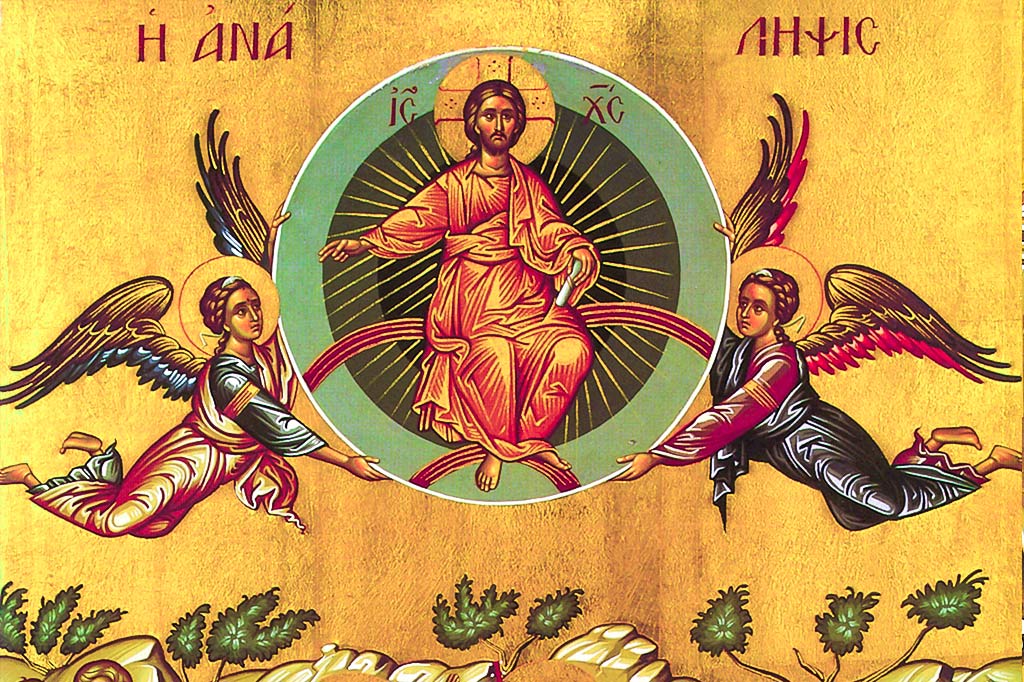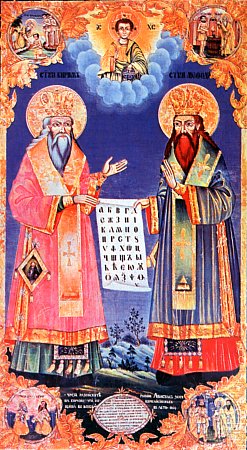 To be truly human in this world is really the same as being a sheep among wolves, for the whole world lieth in wickedness (1 Jn. 5:19). I again say to you, remember: A sheep among wolves is subject to danger from two sides. Firstly, the wolves can tear him apart. But this is in the hands of God. And secondly, a sheep can decide that when you’re surrounded by wolves there is no other way to survive than to become like a wolf, sharpen your teeth, learn how to howl, exchange your hooves for claws, and so from a sheep turn into a wolf. Christ did not send us for this, but so that by our faith and life in the faith we might attract wolves into becoming Christ’s sheep, if they want to.
To be truly human in this world is really the same as being a sheep among wolves, for the whole world lieth in wickedness (1 Jn. 5:19). I again say to you, remember: A sheep among wolves is subject to danger from two sides. Firstly, the wolves can tear him apart. But this is in the hands of God. And secondly, a sheep can decide that when you’re surrounded by wolves there is no other way to survive than to become like a wolf, sharpen your teeth, learn how to howl, exchange your hooves for claws, and so from a sheep turn into a wolf. Christ did not send us for this, but so that by our faith and life in the faith we might attract wolves into becoming Christ’s sheep, if they want to.
Life & Faith
Ascension of our Lord
 The Feast of the Ascension of our Lord God and Savior Jesus Christ is celebrated each year on the fortieth day after the Great and Holy Feast of Pascha (Easter). Since the date of Pascha changes each year, the date of the Feast of the Ascension changes. The Feast is always celebrated on a Thursday. The Feast itself commemorates when, on the fortieth day after His Resurrection, Jesus led His disciples to the Mount of Olives, and after blessing them and asking them to wait for the fulfillment of the promise of the Holy Spirit, He ascended into heaven.
The Feast of the Ascension of our Lord God and Savior Jesus Christ is celebrated each year on the fortieth day after the Great and Holy Feast of Pascha (Easter). Since the date of Pascha changes each year, the date of the Feast of the Ascension changes. The Feast is always celebrated on a Thursday. The Feast itself commemorates when, on the fortieth day after His Resurrection, Jesus led His disciples to the Mount of Olives, and after blessing them and asking them to wait for the fulfillment of the promise of the Holy Spirit, He ascended into heaven.
Saint Cyril and Saint Methodius Equal to the Apostles
 Saints Cyril and Methodius were brothers from Thessalonica of distinguished and wealthy parents, Leo and Maria. The older brother Methodius spent ten years as an officer among the Macedonian Slavs and thus learned the Slavic language. After that Methodius withdrew to Mount Olympus and dedicated himself to the monastic life of asceticism. It was here that Cyril (Constantine) later joined him. When the Khazarite king, Kagan, requested preachers of the Faith of Christ from Emperor Michael III then, by command of the emperor, these two brothers were found and sent among the Khazars. Convincing King Kagan of the Faith of Christ, they baptized him along with a great number of his chief assistants and even a greater number of the people. After a period of time, they returned to Constantinople where they compiled the Slavonic alphabet consisting of thirty-eight letters and proceeded to translate ecclesiastical books from Greek into Slavonic. At the request of Prince Rastislav, they traveled to Moravia where they spread and established the devout Faith and multiplied books and distributed them to the priests to teach the youth. At the request of the pope, Cyril traveled to Rome where he became ill and died on February 14, 867 A.D. Then Methodius returned to Moravia and labored to strengthen the Faith of Christ among the Slavs until his death. Following his death - he died in the Lord on April 6, 885 A.D. - his disciples, THE FIVE FOLLOWERS, with St. Clement, the bishop at the head, crossed the Danube River and descended to the south into Macedonia, where from Ohrid they continued their labor among the Slavs begun by Cyril and Methodius in the north.
Saints Cyril and Methodius were brothers from Thessalonica of distinguished and wealthy parents, Leo and Maria. The older brother Methodius spent ten years as an officer among the Macedonian Slavs and thus learned the Slavic language. After that Methodius withdrew to Mount Olympus and dedicated himself to the monastic life of asceticism. It was here that Cyril (Constantine) later joined him. When the Khazarite king, Kagan, requested preachers of the Faith of Christ from Emperor Michael III then, by command of the emperor, these two brothers were found and sent among the Khazars. Convincing King Kagan of the Faith of Christ, they baptized him along with a great number of his chief assistants and even a greater number of the people. After a period of time, they returned to Constantinople where they compiled the Slavonic alphabet consisting of thirty-eight letters and proceeded to translate ecclesiastical books from Greek into Slavonic. At the request of Prince Rastislav, they traveled to Moravia where they spread and established the devout Faith and multiplied books and distributed them to the priests to teach the youth. At the request of the pope, Cyril traveled to Rome where he became ill and died on February 14, 867 A.D. Then Methodius returned to Moravia and labored to strengthen the Faith of Christ among the Slavs until his death. Following his death - he died in the Lord on April 6, 885 A.D. - his disciples, THE FIVE FOLLOWERS, with St. Clement, the bishop at the head, crossed the Danube River and descended to the south into Macedonia, where from Ohrid they continued their labor among the Slavs begun by Cyril and Methodius in the north.
The Holy Virgin Pelagia
Commemorated May 17
The Holy Virgin Pelagia lived during the III Century in the city of Tarsis in the Cilician district of Asia Minor. She was the daughter of illustrious pagans and when she heard preaching from her Christian acquaintances about Jesus Christ the Son of God, she believed in Him and desired to preserve her chastity, dedicating her whole life to the Lord. The heir of emperor Diocletian (a youth adopted by him), having seen the maiden Pelagia, was captivated by her beauty and wanted to take her to be his wife. But the holy virgin told the youth, that she was betrothed to the Immortal Bridegroom, – the Son of God, and therefore she had renounced earthly marriage.
Sunday of the Samaritan Woman
![]() The Holy Martyr Photina (Svetlana) the Samaritan Woman, her sons Victor (named Photinus) and Joses; and her sisters Anatola, Phota, Photis, Paraskeva, Kyriake; Nero’s daughter Domnina; and the Martyr Sebastian: The holy Martyr Photina was the Samaritan Woman, with whom the Savior conversed at Jacob’s Well (John. 4:5-42).
The Holy Martyr Photina (Svetlana) the Samaritan Woman, her sons Victor (named Photinus) and Joses; and her sisters Anatola, Phota, Photis, Paraskeva, Kyriake; Nero’s daughter Domnina; and the Martyr Sebastian: The holy Martyr Photina was the Samaritan Woman, with whom the Savior conversed at Jacob’s Well (John. 4:5-42).
During the time of the emperor Nero (54-68), who displayed excessive cruelty against Christians, Saint Photina lived in Carthage with her younger son Joses and fearlessly preached the Gospel there. Her eldest son Victor fought bravely in the Roman army against barbarians, and was appointed military commander in the city of Attalia (Asia Minor). Later, Nero called him to Italy to arrest and punish Christians.
On Guilelessness and Wisdom
The Burning of Relics of Saint Sava
 Sava was the Archbishop of the Serbs. The body of St. Sava was buried in Mileshevo Monastery. During the time of the Turkish tyranny, the Serbian people gathered around the relics of their saint to seek comfort and healing.
Sava was the Archbishop of the Serbs. The body of St. Sava was buried in Mileshevo Monastery. During the time of the Turkish tyranny, the Serbian people gathered around the relics of their saint to seek comfort and healing.
Fearing that an insurrection might arise from that place against the Turks, Sinan Pasha of Belgrade ordered that the relics of St. Sava be translated to Belgrade and there to be burned on Vracar, April 27, 1594 A.D. With the burning of the relics of this saint, the rabid Pasha did not burn the saint who remained alive before the Throne of God in the heavens and in the hearts of his people on earth.

